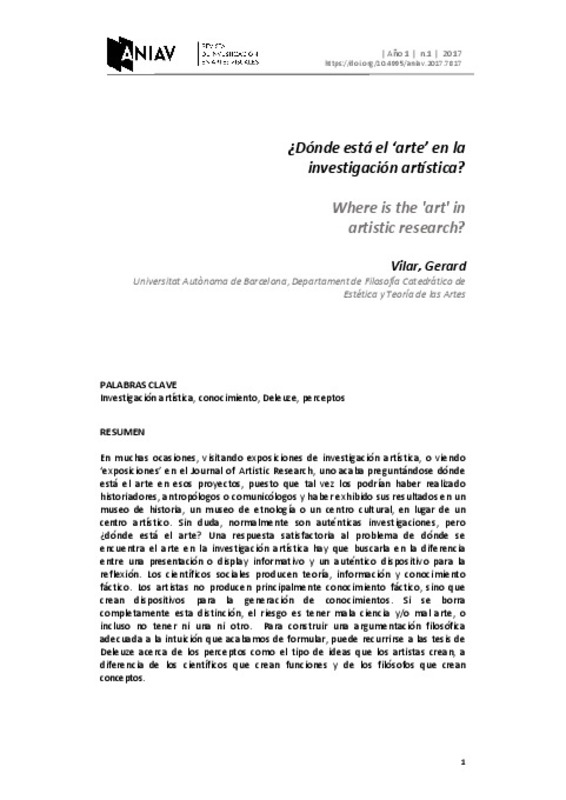JavaScript is disabled for your browser. Some features of this site may not work without it.
Buscar en RiuNet
Listar
Mi cuenta
Estadísticas
Ayuda RiuNet
Admin. UPV
¿Dónde está el ‘arte’ en la investigación artística?
Mostrar el registro sencillo del ítem
Ficheros en el ítem
| dc.contributor.author | Vilar, Gerard
|
es_ES |
| dc.date.accessioned | 2017-07-12T10:54:55Z | |
| dc.date.available | 2017-07-12T10:54:55Z | |
| dc.date.issued | 2017-07-05 | |
| dc.identifier.uri | http://hdl.handle.net/10251/85009 | |
| dc.description.abstract | [EN] Frequently, visiting artistic research exhibitions, or seeing 'exhibitions' in the Journal of Artistic Research, one ends up wondering where art is in those projects, since perhaps they could have been done by historians, anthropologists or communicologists and exhibited their results in a history or ethnology museum, or a cultural center whatever, rather than in an artistic center. No doubt, they are usually true research, but where is the art? A satisfactory answer to the problem of where art is in artistic research is to be find in the difference between an informative presentation or display and an authentic device for reflection. Social scientists produce theory, information, and factual knowledge. Artists do not primarily produce factual knowledge, butrather create devices for the generation of knowledge. If this distinction is completely erased, the risk is to have bad science and/or bad art, or even have neither. To build a philosophical argumentation appropriate to the intuition that we have just formulated, it is possible to have recourse to Deleuze's theses about percepts as the kind of ideas that artists create, unlike the scientists who create functions and the philosophers who create concepts. | es_ES |
| dc.description.abstract | [ES] En muchas ocasiones, visitando exposiciones de investigación artística, o viendo ‘exposiciones’ en el Journal of Artistic Research, uno acaba preguntándose dónde está el arte en esos proyectos, puesto que tal vez los podrían haber realizado historiadores, antropólogos o comunicólogos y haber exhibido sus resultados en un museo de historia, un museo de etnología o un centro cultural, en lugar de un centro artístico. Sin duda, normalmente son auténticas investigaciones, pero ¿dónde está el arte? Una respuesta satisfactoria al problema de dónde se encuentra el arte en la investigación artística hay que buscarla en la diferencia entre una presentación o display informativo y un auténtico dispositivo para la reflexión. Los científicos sociales producen teoría, información y conocimiento fáctico. Los artistas no producen principalmente conocimiento fáctico, sino que crean dispositivos para la generación de conocimientos. Si se borra completamente esta distinción, el riesgo es tener mala ciencia y/o mal arte, o incluso no tener ni una ni otro. Para construir una argumentación filosófica adecuada a la intuición que acabamos de formular, puede recurrirse a las tesis de Deleuze acerca de los perceptos como el tipo de ideas que los artistas crean, a diferencia de los científicos que crean funciones y de los filósofos que crean conceptos. | es_ES |
| dc.language | Español | es_ES |
| dc.publisher | Universitat Politècnica de València | |
| dc.relation.ispartof | ANIAV - Revista de Investigación en Artes Visuales | |
| dc.rights | Reconocimiento (by) | es_ES |
| dc.subject | Investigación artística | es_ES |
| dc.subject | Conocimiento | es_ES |
| dc.subject | Deleuze | es_ES |
| dc.subject | Perceptos | es_ES |
| dc.subject | Artistic research | es_ES |
| dc.subject | Knowledge | es_ES |
| dc.subject | Percepts | es_ES |
| dc.title | ¿Dónde está el ‘arte’ en la investigación artística? | es_ES |
| dc.title.alternative | Where is the 'art' in artistic research? | es_ES |
| dc.type | Artículo | es_ES |
| dc.date.updated | 2017-07-12T10:39:40Z | |
| dc.identifier.doi | 10.4995/aniav.2017.7817 | |
| dc.rights.accessRights | Abierto | es_ES |
| dc.description.bibliographicCitation | Vilar, G. (2017). ¿Dónde está el ‘arte’ en la investigación artística?. ANIAV - Revista de Investigación en Artes Visuales. (1):1-8. https://doi.org/10.4995/aniav.2017.7817 | es_ES |
| dc.description.accrualMethod | SWORD | es_ES |
| dc.relation.publisherversion | https://doi.org/10.4995/aniav.2017.7817 | es_ES |
| dc.description.upvformatpinicio | 1 | es_ES |
| dc.description.upvformatpfin | 8 | es_ES |
| dc.type.version | info:eu-repo/semantics/publishedVersion | es_ES |
| dc.description.issue | 1 | |
| dc.identifier.eissn | 2530-9986 | |
| dc.description.references | Deleuze, G. Y Guatari, F. (1993). ¿Qué es Filosofía?. Barcelona: Anagrama. | es_ES |
| dc.description.references | Kant, I. (1995). Crítica del Juicio. Madrid: Espasa Calpe. | es_ES |
| dc.description.references | Steyerl, H. (2015). Duty-Free Art, catálogo de la exposición. Madrid: MNCARS. | es_ES |
| dc.description.references | Vilar, G. (2017). El valor cognitivo del arte. En Pérez Carreño, F. (ed.), El valor del arte. Madrid: Machado. | es_ES |








